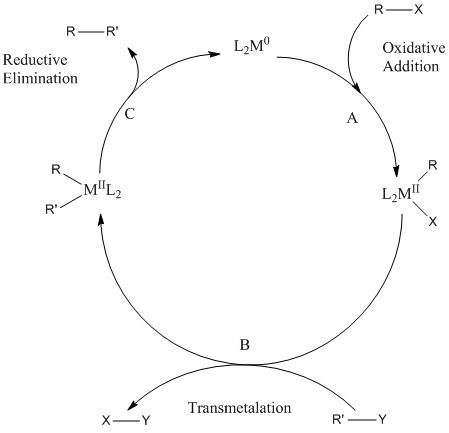 | ||
A coupling reaction in organic chemistry is a general term for a variety of reactions where two hydrocarbon fragments are coupled with the aid of a metal catalyst. In one important reaction type a main group organometallic compound of the type RM (R = organic fragment, M = main group centre) reacts with an organic halide of the type R'X with formation of a new carbon-carbon bond in the product R-R'
Contents
- Mechanism
- Catalysts
- Leaving groups
- Operating conditions
- Coupling types
- Miscellaneous reactions
- Applications
- References
Richard F. Heck, Ei-ichi Negishi and Akira Suzuki were awarded the 2010 Nobel Prize in Chemistry for developing palladium catalyzed cross coupling reactions.
Broadly speaking, two types of coupling reactions are recognized:
Mechanism
The reaction mechanism generally begins with the oxidative addition of an organic halide to the catalyst. Subsequently, the second partner undergoes transmetallation, which places both coupling partners on the same metal center while eliminating the functional groups. The final step is reductive elimination of the two coupling fragments to regenerate the catalyst and give the organic product. Unsaturated organic groups couple more easily in part because they add readily. The intermediates are also less prone to beta-hydride elimination.
In one computational study, unsaturated organic groups were shown to undergo much easier coupling reaction on the metal center. The rates for reductive elimination followed the following order: vinyl-vinyl > phenyl-phenyl > alkynyl-alkynyl > alkyl-alkyl. The activation barriers and the reaction energies for unsymmetrical R-R′ couplings were found to be close to the averages of the corresponding values of the symmetrical R-R and R′-R′ coupling reactions; for example: vinyl-vinyl > vinyl-alkyl > alkyl-alkyl. Another mechanistic approach proposes that specifically in aqueous solutions, coupling actually occurs via a radical mechanism rather than a metal-assisted one. Most of the coupling reaction's mechanisms slightly vary from this generalized form.
Catalysts
The most common catalyst is palladium, but an increasing number of reactions use nickel. Other catalysts include copper, platinum, iron, cobalt, and amines.
Palladium is robust catalyst and is frequently used due to high functional group tolerance, and low sensitivity of organopalladium compounds towards water and air. However, palladium is a quite rare and costly noble metal. Additionally palladium catalysts are notoriously difficult to remove. Purification typically involves extensive column chromatography, recrystallization, metal scavengers, distillation, or extraction to name a few techniques. Most methods typically do not completely remove the catalyst. This typically causes issues for the pharmaceutical industry which faces extensive regulation regarding heavy metals. Many pharmaceutical chemists attempt to use coupling reactions early in production to minimize metal traces in the product.
Nickel catalysts, while less robust than palladium ones, are cheaper, easier to remove, and less toxic. Nickel catalysts frequently require energetic substrates or co-catalysts such as Photoredox catalysts. Currently, many research groups are trying to create heterogeneous reusable catalysts to minimize cost and reduce purification needs.
Most catalysts use bulky L type ligands such as triphenylphosphine,
In depth-reviews have been written for example on cobalt, palladium and nickel mediated reactions and on applications
Leaving groups
The leaving group X in the organic partner is usually a halogen. Chloride is the most ideal group due to their low cost, but frequently have issues with reactivity. The main group metal in the organometallic partner usually is tin, zinc, silates or boron.
Operating conditions
While many coupling reactions involve reagents that are extremely susceptible to presence of water or oxygen, it is unreasonable to assume that all coupling reactions need to be performed with strict exclusion of water. It is possible to perform palladium-based coupling reactions in aqueous solutions using the water-soluble sulfonated phosphines made by the reaction of triphenyl phosphine with sulfuric acid. Another example of coupling in aqueous media, with the main reacting agent being trimolybdenum-alkylidyne clusters, is that of Bogoslavsky et al. In general, the oxygen in the air is more able to disrupt coupling reactions, because many of these reactions occur via unsaturated metal complexes that do not have 18 valence electrons. For example, in nickel and palladium cross couplings, a zerovalent complex with two vacant sites (or labile ligands) reacts with the carbon halogen bond to form a metal halogen and a metal carbon bond. Such a zerovalent complex with labile ligands or empty coordination sites is normally very reactive toward oxygen.
Some catalysts might be easily poisoned by heterocycles under prolonged reaction at elevated temperature. To avoid this, chemists often use pressure reactors to accelerate reactions at high temperature and pressure. Q-Tube and microwave synthesizer are available safe pressure reactors.
Coupling types
Coupling reactions include (not exhaustive):
Miscellaneous reactions
In one study, an unusual coupling reaction was described in which an organomolybdenum compound, [Mo3(CCH3)2(OAc)6(H2O)3](CF3SO3)2 not only sat on a shelf for 30 years without any sign of degradation but also decomposed in water to generate 2-butyne, which is the coupling adduct of its two ethylidyne ligands. This, according to the researchers, opens another way for aqueous organometallic chemistry.
One method for palladium-catalyzed cross-coupling reactions of aryl halides with fluorinated arenes was reported by Keith Fagnou and co-workers. It is unusual in that it involves C-H functionalisation at an electron deficient arene.
Applications
Many coupling reactions have found their way into pharmaceutical industry and into conjugated organic materials
